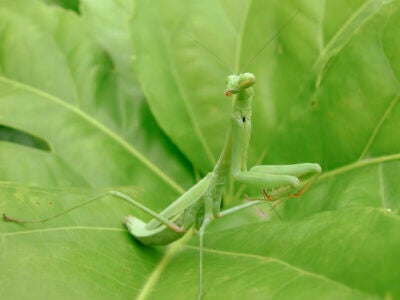Praying Mantises: Nature’s tiny, weird superheroes
Published 2:41 pm Wednesday, September 18, 2024
|
Getting your Trinity Audio player ready...
|
Watching a praying mantis turn its head to look at me is fascinating yet a little unnerving since they look like alien creatures. Looking closely at your garden, you might just see one of these cool insects. These amazing creatures are tiny superheroes of the bug world, and in Western North Carolina, we’re lucky to have these incredible creatures living all around us.
Praying mantises might look a bit weird, but they’re super cool. They’re the only insects that can turn their heads 180 degrees, meaning they can look behind them without moving their bodies, just like an owl. Imagine being able to see behind you without moving your body. That’s just one of their superpowers!
These insects got their name because their front legs look like they’re folded in prayer. But don’t be fooled – those legs are actually powerful weapons! Praying mantises use them to grab their food faster than you can blink. They’re like the ninja warriors of the insect world.
Trending
Praying mantises are the guardians of our gardens. They eat other insects like flies, crickets, and moths that can often damage plants. Some big non-native mantises can even catch small birds or lizards! In rare cases, really big praying mantises can actually catch and eat hummingbirds. Don’t worry, though; this doesn’t happen very often, and hummingbirds are usually way too fast for mantises.
Praying mantises have another superpower – camouflage. They come in different colors, like green and brown, which helps them blend in with leaves and twigs. This makes it hard for their enemies to spot them and easy for them to sneak up on their prey. It’s like they have invisible cloaks.
And here’s another fun fact that might surprise you: praying mantises have ears… on their bellies! Yep, that’s right. They have a special ear between their back legs that helps them hear high-pitched sounds. This ear is especially good at hearing bats, which like to eat mantises at night.
In Western North Carolina, we have several types of praying mantises. Our native superhero is the Carolina mantis, which is smaller than some other mantises. It’s usually about two inches long and brownish-gray, which helps it blend in with tree bark.
We also have some non-native mantis species that came from other parts of the world, like the Chinese and European mantis. And while they eat lots of bugs in your yard, they unfortunately outcompete the Carolina mantis for food.
Praying mantises are tough, but they still need our help to thrive in the wild. One big way we can help is by not using pesticides in our gardens. These chemicals kill not just harmful bugs but also pollinators and other beneficial insects. Since mantises are natural pest controllers, if we let them do their job, we won’t need those harmful chemicals.
Trending
Another way to help is by leaving some wild areas in our yards. Mantises love places with tall grass and wildflowers. These spots give them places to hide, hunt, and lay their eggs. If you find a brown, foamy-looking egg case on a twig in winter, please leave it be! Baby mantises will hatch from it in spring.
Remember, every superhero needs a sidekick. By taking care of our gardens and green spaces, we can be the sidekicks that help praying mantises continue their important work in Western North Carolina. Let’s team up with these tiny superheroes and make our part of the world a little bit greener!

A Carolina mantis can move its head 180 degrees, just like an owl. (Photo by Mathew Radar)
Loti Woods is co-founder of Champions for Wildlife, a local nonprofit organization whose mission is to inspire kids to be champions for wildlife through the power of art and education. To learn more, visit www.championsforwildlife.org.






